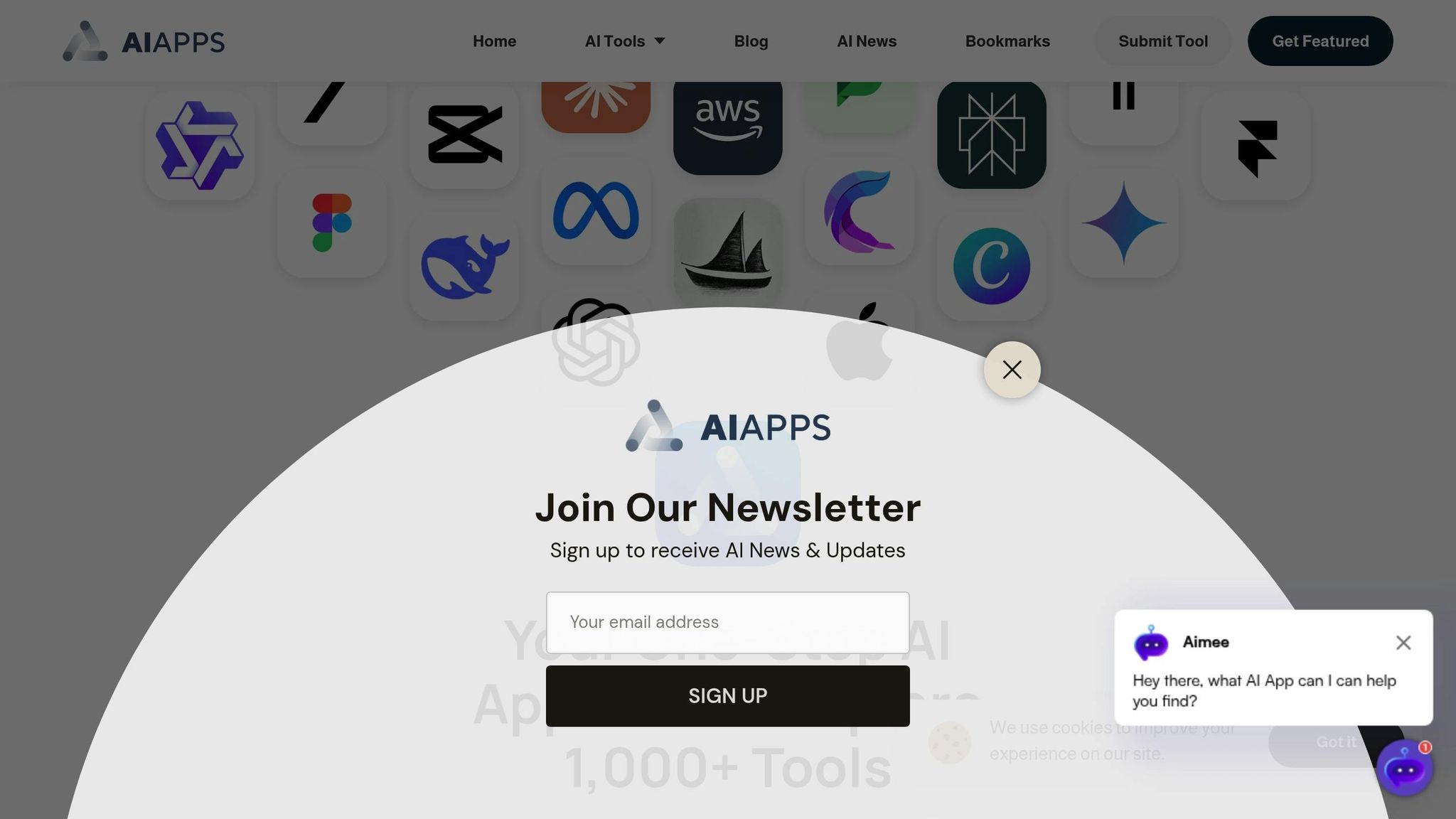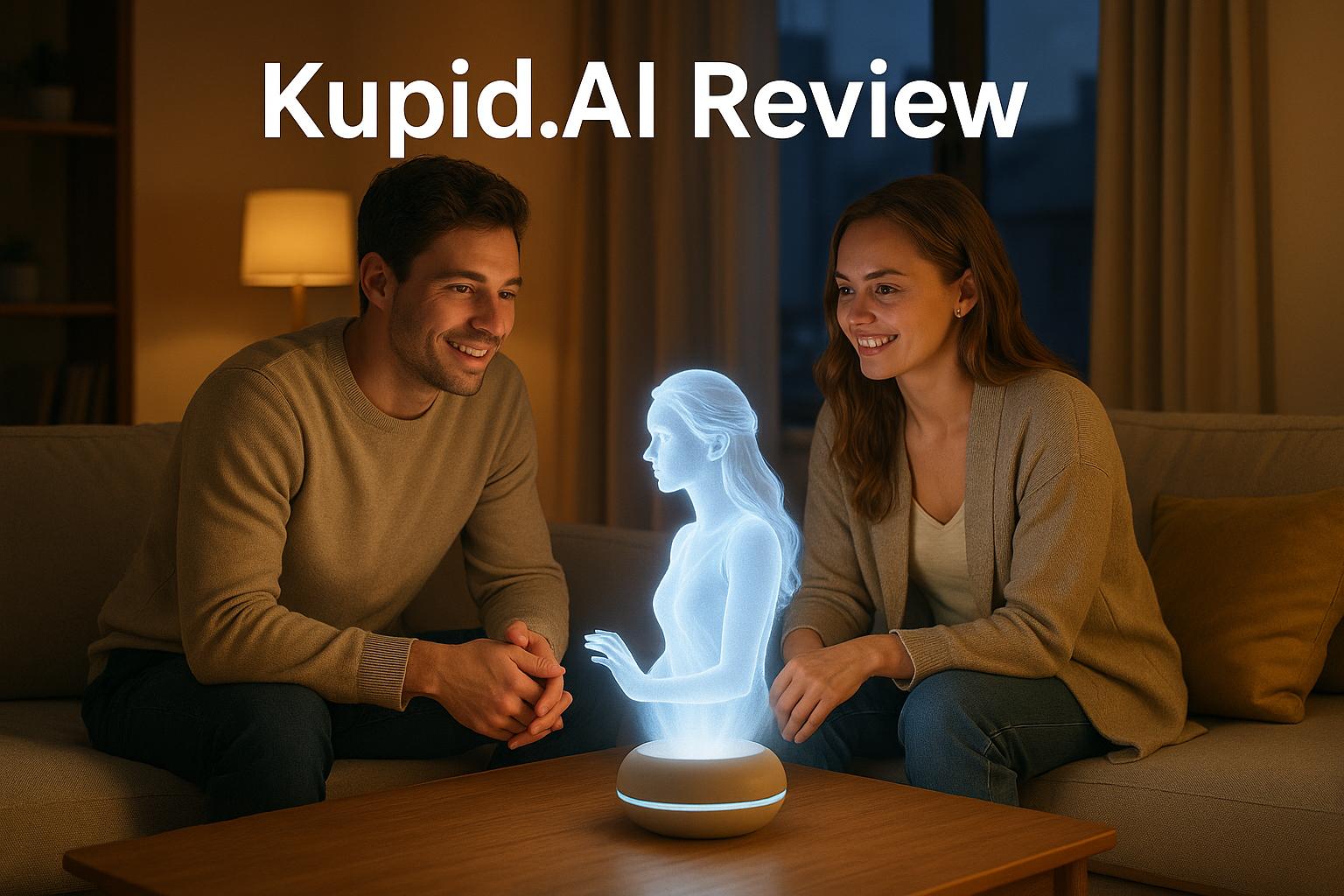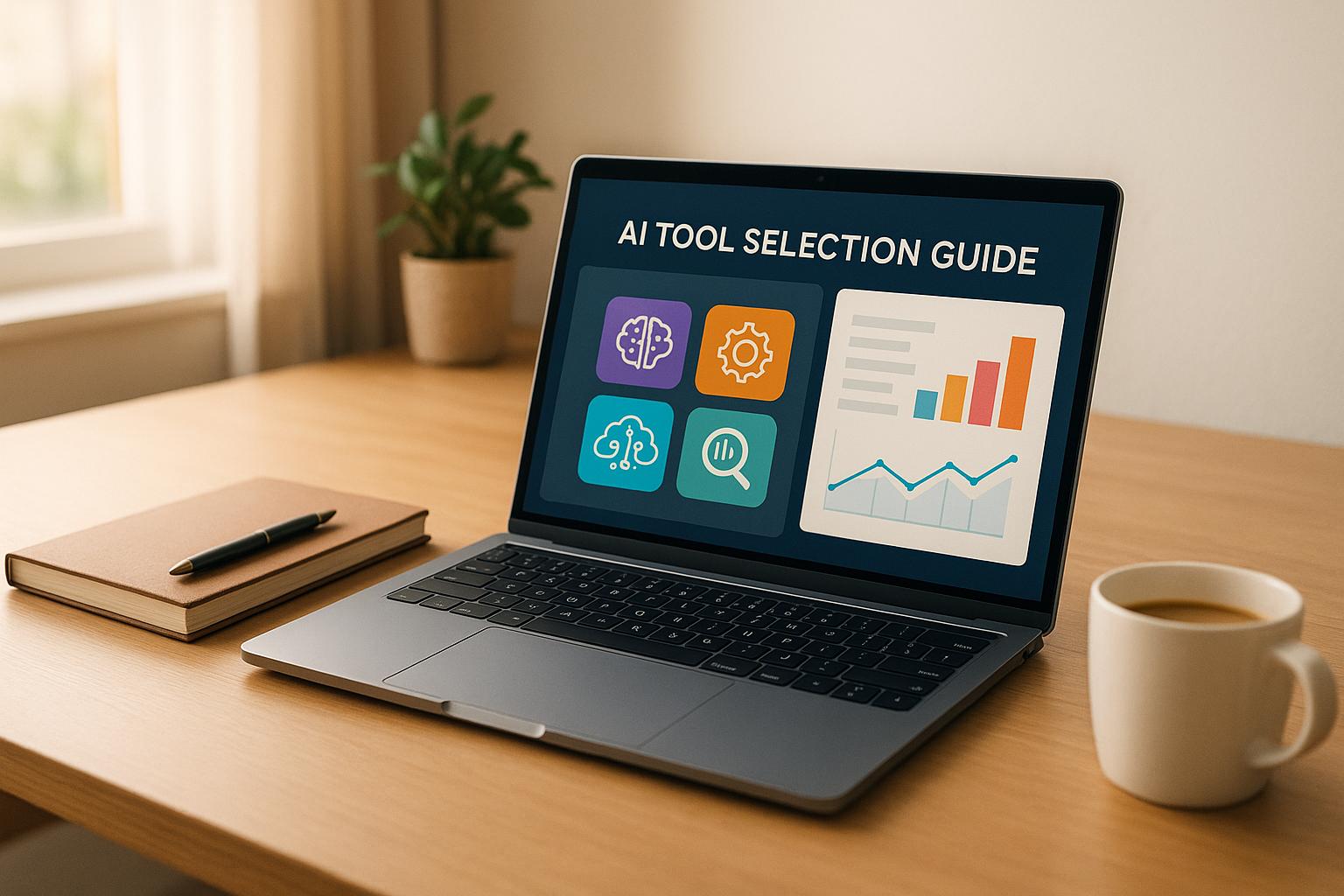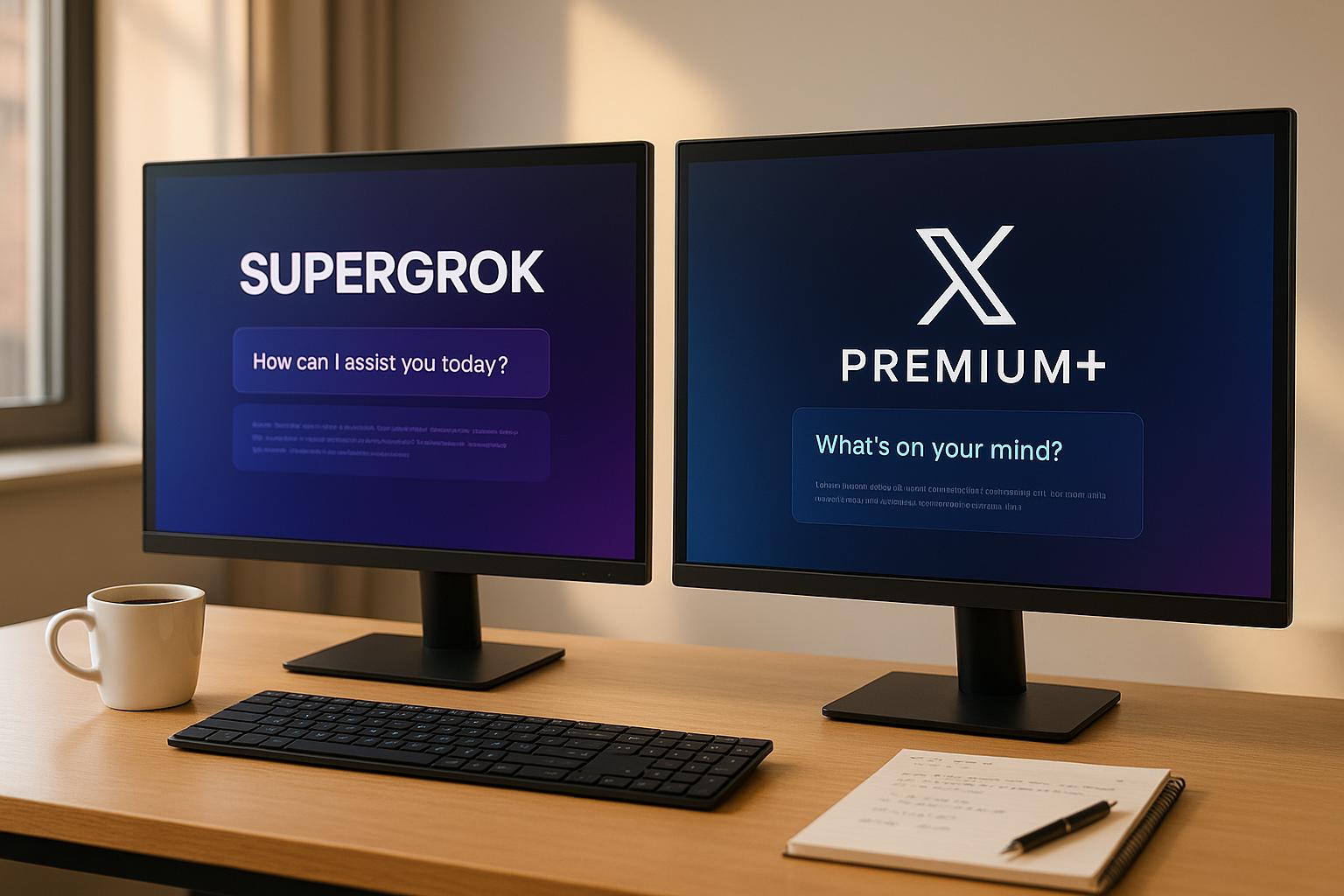AI tools simplify social media management by automating data analysis and optimizing performance metrics. Instead of manually tracking numbers, these tools provide actionable insights in seconds, helping you focus on what matters most. Here are the five key metrics AI tools improve:
- Engagement Rate: Tracks interactions like likes, comments, and shares to measure content appeal. AI identifies patterns and suggests improvements.
- Reach and Impressions: Measures visibility and content exposure. AI optimizes posting times, formats, and hashtags to grow audience size.
- Audience Growth: Monitors follower increases over time. AI predicts trends and recommends strategies to attract new followers.
- Audience Retention: Focuses on keeping followers engaged. AI detects disengagement early and personalizes re-engagement campaigns.
- Sentiment Analysis: Analyzes audience emotions in real-time, offering insights into public opinion and spotting potential PR issues.
AI tools save time, reduce errors, and provide deeper insights compared to manual methods. Platforms like AI Apps offer access to a wide range of tools to help businesses boost their social media performance.
1. Engagement Rate: Tracking User Interactions
What is Engagement Rate
Engagement rate is a percentage that shows how many people interact with your content compared to the number of people who see it. It’s a great way to gauge how appealing your content is. Interactions can include likes, comments, shares, clicks, saves, and reactions.
To calculate it, take the total interactions, divide that by the total reach or impressions, and multiply by 100. For instance, if a post gets 500 interactions and reaches 10,000 people, the engagement rate would be 5%.
Keep in mind, different platforms might calculate engagement rates differently. Some use reach (the number of unique viewers), while others use impressions (the total number of times content is displayed). Understanding these differences is key to setting realistic goals for each platform.
How AI Tools Track Engagement Better
AI tools make tracking engagement easier by automating data collection and analysis across multiple platforms. Instead of juggling numbers manually, these tools pull everything into one dashboard, giving you a clear picture of how your audience is responding in real time.
With AI, you can see patterns in engagement - like which posts are getting the most attention or the best times to post. This kind of insight is invaluable for fine-tuning your content strategy and keeping your audience engaged.
Why AI Works Better Than Manual Methods
Tracking engagement manually can be a hassle. It’s time-consuming and leaves room for mistakes, like missing data or inconsistent tracking periods. AI tools eliminate these issues by automating the process, ensuring you get accurate and consistent results.
Beyond just tracking, AI tools provide actionable insights. They analyze past performance to help you improve future posts, and they can handle data from multiple platforms at once. This makes it easier to manage your social media efforts and boost your overall performance metrics.
2. Reach and Impressions: Growing Your Audience Size
Reach vs Impressions Explained
Reach refers to the number of unique individuals who see your content, while impressions count how often your content is displayed, including repeat views by the same person. For example, if 100 people see your post once, your reach is 100. However, if those same 100 people view it three times each, that results in 300 impressions.
This distinction is important because it helps you understand how your content performs. A high reach indicates you're expanding your visibility, while high impressions with a lower reach suggest your message is being reinforced among your existing audience.
Most social media platforms, like Facebook, Instagram, Twitter, and LinkedIn, provide these metrics in their analytics tools. These insights help you determine if your content is attracting new viewers or resonating with your current followers.
With this foundation, AI tools can step in to help boost both reach and impressions more strategically.
AI Methods for Increasing Reach
AI can transform how you grow your audience by analyzing your data and providing actionable insights. Here’s how it works:
- Timing Optimization: AI identifies the best times to post based on your audience's activity patterns, ensuring your content appears when engagement is likely to be highest.
- Content Format Analysis: By studying your past performance, AI determines which types of posts - whether videos, images, or carousels - get the most engagement. It also tracks emerging trends to keep your content fresh and relevant.
- Audience Segmentation: AI breaks down your audience into smaller groups, allowing you to target each segment with tailored content. This personalized approach can significantly improve reach by aligning with specific audience interests.
- Hashtag Recommendations: AI analyzes millions of posts to find hashtags that strike the right balance between popularity and competition. This helps your content reach new audiences without getting buried under highly competitive tags.
By leveraging these AI-driven strategies, you can expand your content's visibility while staying ahead of trends.
AI vs Manual Reach Analysis
AI offers a level of speed and precision that manual analysis simply can’t match. Here’s why it stands out:
- Real-Time Monitoring: AI continuously tracks your reach metrics and provides updated recommendations as performance changes. In contrast, manual analysis can take hours and often misses fast-moving trends.
- Trend Detection: With AI, you’ll spot shifts in content preferences - like videos outperforming images - right as they happen. This allows you to adjust your strategy before the trend fades, unlike manual methods that may lag behind.
- Streamlined Testing: AI can run multiple A/B tests simultaneously, evaluating factors like posting times, formats, captions, and hashtags. This approach delivers quicker insights compared to the slow, one-variable-at-a-time testing often used in manual analysis.
3. Audience Growth: Building Your Follower Base
What is Audience Growth
Audience growth tracks how your follower count evolves over time, offering a big-picture view of your social media community's expansion. Unlike metrics like reach or impressions that focus on the performance of individual posts, audience growth zeroes in on whether you're consistently attracting new followers who want to stay engaged with your brand.
Calculating audience growth is simple: subtract your starting follower count from your ending count within a specific timeframe. To dig deeper, look at your growth rate - the percentage increase relative to your initial audience size. For instance, if you start with 1,000 followers and gain 100 more, that's a 10% growth rate. Monitoring this monthly or quarterly can reveal trends and help you adjust your strategy. Let’s see how AI tools can make tracking and predicting these trends easier.
AI Tools for Growth Tracking and Prediction
With AI tools, audience growth management shifts from simply observing numbers to crafting forward-thinking strategies. These tools analyze historical data to uncover patterns in how you gain followers and predict what’s likely to happen next.
AI evaluates factors like posting frequency, content formats, and engagement levels to identify what drives follower growth. Predictive models use past trends to estimate future growth under different scenarios, helping you set achievable goals and allocate resources effectively. Now, let’s explore how platforms like AI Apps simplify access to these advanced capabilities.
Using AI Apps for Audience Data

AI Apps offers tailored tools to make audience growth analytics more accessible and actionable.
The platform includes features for demographic analysis, helping you understand your current followers and pinpoint gaps in your target audience. It also provides content optimization tools that suggest post types and topics proven to attract followers for accounts similar to yours.
Growth prediction tools on AI Apps let you test different content strategies and forecast potential follower increases. This data-driven approach empowers smarter decisions and helps you make the most of your marketing efforts.
Additionally, many tools on AI Apps provide real-time monitoring with automated alerts, so you’re always aware of major changes in your growth metrics. To top it off, the platform uses a multi-step verification process to ensure all its tools are thoroughly tested for quality and reliability, saving you time and giving you confidence in your choices.
4. Audience Retention: Keeping Followers Active
What is Audience Retention
Audience retention is all about maintaining an engaged, active group of followers over time, rather than watching them drift into inactivity. It goes beyond just tracking how many followers you have - it’s about the quality of the connection and how long that connection lasts.
Think of it this way: retention separates a loyal, interactive audience from a revolving door of one-time visitors. When retention is strong, followers consistently like, comment on, and share your content, showing genuine interest in what you’re putting out there. On the flip side, low retention might mean people are losing interest or tuning out entirely.
Retention rates are often measured over specific timeframes - like 30, 60, or 90 days - by tracking activities such as likes, comments, shares, story views, and messages. The goal is to spot early warning signs of disengagement, and this is where AI tools can shine by detecting subtle patterns in user behavior.
Understanding retention lays the groundwork for seeing how AI can help you keep your audience engaged.
How AI Improves Retention Numbers
AI takes audience retention to the next level by shifting the focus from reacting to problems to actively building stronger relationships. With its ability to analyze massive amounts of data, AI can pinpoint trends and behaviors that might otherwise go unnoticed.
For example, churn prediction uses machine learning to identify followers at risk of losing interest. It looks at things like declining engagement, shorter content views, or changes in interaction habits. This early detection gives you the chance to reconnect with these followers before they slip away.
AI also enables hyper-personalized content strategies. Instead of using a broad, one-size-fits-all approach, AI tools can track individual preferences, identify the best times to post, and figure out which content formats resonate most with different segments of your audience. This tailored approach makes followers feel more connected to your brand.
Automated retention campaigns take personalization even further. If AI detects a drop in engagement, it can trigger immediate actions like sending personalized messages, offering exclusive content, or running targeted ads. These campaigns work continuously to address potential retention issues before they escalate.
AI can also help you fine-tune your content strategy by analyzing why followers disengage. For instance, you might discover that your audience prefers video content on certain days but engages more with text posts on others. Recognizing these patterns allows you to adjust your approach in real time.
AI Retention Campaign Examples
AI-powered retention campaigns focus on specific audience segments with targeted strategies to keep followers engaged.
- Re-engagement sequences: If a once-active follower hasn’t interacted with your content for a while, AI can automatically send a personalized message or exclusive offer to grab their attention again. These campaigns might include polls, behind-the-scenes content, or time-sensitive offers tailored to their previous preferences.
- Loyalty campaigns: AI helps identify your most engaged followers and rewards them with perks like early access to announcements or exclusive content. This kind of recognition not only keeps them engaged but also strengthens their connection to your brand.
- Win-back campaigns: For followers showing signs of declining interest, AI can prompt actions like surveys, invitations to live Q&A sessions, or personalized content recommendations. Timing is crucial here, and AI ensures these efforts reach followers when they’re most likely to respond.
- Sentiment-based campaigns: By analyzing the emotional tone of interactions, AI can detect when a follower is frustrated or upset. In these cases, it might trigger a customer service response or offer special attention to address their concerns before they disengage completely.
These AI-driven tactics ensure that your retention strategies are not only timely but also deeply personalized, helping you maintain a loyal and active audience.
sbb-itb-212c9ea
5. Social Media Sentiment Analysis: Measuring Audience Opinions
What is Sentiment Analysis
While engagement metrics like likes and shares are important, sentiment analysis digs deeper, giving you insight into how your audience truly feels about your brand, products, or content. It’s all about analyzing the emotions behind the comments, mentions, and reviews your brand receives across social media platforms.
Sentiment analysis works by categorizing feedback into positive, negative, or neutral sentiments. It’s like reading between the lines of every interaction - whether it’s a comment on a post, a direct message, or a mention in a story. Unlike basic metrics, this approach captures the tone and context of audience expressions. For example, it can detect sarcasm, humor, or references that might alter the intended meaning, giving you a more accurate understanding of public perception.
Why does this matter? Because knowing how people feel about your brand helps you assess whether your social media strategies are creating a positive impression or if there are hidden issues that need attention. It’s also a powerful way to spot shifts in audience opinion early, allowing you to act before minor concerns turn into major problems. This groundwork makes AI-powered, real-time sentiment tracking even more impactful.
AI Tools for Real-Time Sentiment Tracking
AI tools have revolutionized sentiment analysis by processing huge amounts of data in real time, something manual methods simply can’t keep up with. Using natural language processing and machine learning, these tools go beyond basic keyword tracking. They can interpret context, sarcasm, slang, emojis, and even subtle emotional undertones that traditional methods often miss.
These tools are designed to handle thousands of mentions at once, ensuring consistent analysis across all platforms. For example, the moment your brand posts new content or a trending topic emerges, AI tools immediately begin analyzing audience reactions. Within minutes, they can alert you to major sentiment changes, giving you the ability to respond quickly.
One standout feature of AI sentiment analysis is its ability to detect nuanced emotions. It doesn’t just label feedback as positive or negative - it identifies feelings like excitement, frustration, or confusion. This level of detail helps you better understand your audience’s reactions and adjust your approach accordingly.
AI-driven sentiment analysis tools are also constantly improving. They learn from new data patterns, adapting to changes in language and evolving slang without requiring frequent manual updates. According to recent data, the use of AI in customer feedback analysis has grown by 30% in the past year, and 75% of companies plan to increase their investment in these tools by 2026.
Using AI to Prevent PR Problems
AI doesn’t just help you understand audience sentiment - it also acts as an early warning system for potential PR crises. By spotting negative sentiment trends early, AI tools allow you to step in and address issues before they spiral out of control.
AI’s pattern recognition capabilities are key here. It can detect unusual spikes in negative sentiment - like a sudden surge of frustrated comments - within minutes. This speed is critical for crisis management. While traditional methods might take hours or even days to identify a problem, AI can alert your team in real time, giving you the opportunity to respond quickly and effectively.
Beyond just identifying problems, AI tools can also analyze the underlying themes driving negative sentiment. This means you can craft responses that address the root cause of the issue, not just the surface-level complaints. In some cases, this proactive approach can even turn dissatisfied customers into loyal advocates.
For brands exploring sentiment analysis tools, platforms like AI Apps make it easy to find the right fit. With a curated selection of over 1,000 AI tools, you can filter by category and pricing model to discover solutions that meet your needs. This simplifies the process of implementing sentiment tracking across all your social media channels, ensuring you stay ahead of audience sentiment at all times.
7 Social Media Metrics You Need to Track
Conclusion: AI Tools Transform Social Media Metrics
AI tools are reshaping how businesses track and understand social media metrics. Gone are the days of relying solely on basic stats and manual analysis. Now, companies can monitor engagement rates, audience growth, reach, retention, and sentiment with unmatched accuracy and speed. These tools process massive amounts of data in real time, uncovering patterns that lead to actionable insights.
But AI doesn’t stop at just collecting data. It provides predictive insights that help brands stay ahead of trends and avoid potential PR disasters. By spotting subtle shifts in audience behavior and analyzing complex emotional responses, these tools can even fine-tune campaigns on the fly for better results. This level of sophistication makes it easier than ever to choose the right tools for your needs.
For those looking to take their analytics further, AI Apps offers a curated platform to discover AI solutions tailored to your goals. With advanced search features and a mix of free and premium options, AI Apps connects you to tools designed for tasks like boosting engagement, running sentiment analysis, or predicting audience growth. Every featured tool is rigorously vetted, giving you confidence in its ability to enhance your social media performance.
Whether you're focused on improving engagement, expanding your reach, or understanding your audience’s sentiment, AI tools empower every aspect of your strategy. Early adopters are already gaining a competitive edge by using AI for deeper audience insights, smarter content strategies, and stronger social media presence. If you want to stay relevant in today’s fast-moving digital landscape, now’s the time to embrace AI.
FAQs
How can AI tools help boost engagement rates on social media?
AI tools dig into metrics like likes, comments, shares, and even audience sentiment to figure out what kind of content strikes a chord with your followers. By spotting trends in how users interact, these tools help refine your content strategy, zeroing in on the posts that spark the most engagement.
On top of that, AI tools can fine-tune your posting schedule by analyzing when your audience is most active. This ensures your content lands in front of the right people at the perfect time, giving marketers the insights they need to make smarter, data-driven tweaks and keep boosting engagement.
How do AI tools help boost audience growth and keep followers engaged?
AI tools play a key role in boosting audience growth and engagement by diving deep into user behavior, preferences, and trends. With these insights, you can create personalized content that truly connects with your audience, making interactions more meaningful and impactful.
On top of that, AI-powered automation - like chatbots - keeps communication flowing smoothly by delivering quick and consistent responses to inquiries. This sense of reliability and connection helps maintain active engagement and encourages followers to remain loyal to your brand.
How can AI sentiment analysis help brands avoid PR issues on social media?
AI-powered sentiment analysis enables brands to keep a close eye on public opinion as it unfolds, helping them spot negative trends early. This gives businesses the chance to tackle concerns before they grow into bigger issues, ultimately protecting their reputation.
By examining sentiment patterns, these tools can predict potential challenges and offer actionable insights. This approach not only reduces the likelihood of PR troubles but also helps build stronger trust and deeper connections with audiences.



